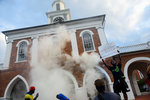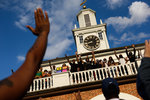





Early on the morning of May 30, 2020, Fayetteville Police Chief Gina Hawkins received a text message: People – “some peaceful, some not” – are planning to gather in the city to protest the murder of Fayetteville native George Floyd.
Around 1 a.m. that day, Hawkins received another message: “We are starting to see more posts from people threatening to burn down the Market House. That would be their first target.”
Those revelations are part of a 76-page report from the Police Executive Research Forum – or PERF – which reviewed the Police Department’s response to the violent protests, its use of deadly force policies and the effects of the COVID-19 pandemic on its operations.
The report was requested by the city and became available Thursday following a public records request by former City Councilman Ted Mohn in December and by CityView TODAY in January.
The report congratulated the Police Department on how officers are trained, its policies and procedures concerning the use of deadly force, and its handling of the pandemic, although it made recommendations in all of those areas.
The report’s biggest criticism targeted the department’s lack of communication from the top down.
“Interviews with FPD personnel found that the decisions made by department leaders on May 30 (specifically, the stand-down order) and the reasoning behind the decisions were not communicated well — with officers, supervisors, and the community,” the report said.
The report said morale could be “greatly improved” by better communication.
The nonprofit PERF organization chose not to say outright whether Hawkins was right to order police to stand down when the protests of May 30 turned violent.
Hawkins orders police to stand down
According to the report, Hawkins followed department policy regarding special events and passive protests rather than order her officers to try to keep the peace in the face of an ever-larger group of demonstrators – some of whom were armed – that had turned increasingly violent.
The demonstrations began at 3 p.m. with a peaceful protest organized by community activist Rakeem Jones at the Walmart on Skibo Road. Later, demonstrators got word that another, separate protest would be held at 5 p.m. in front of the Market House, and the crowd began to move that way.
For a time, Fayetteville rapper J. Cole and NBA player Dennis Smith Jr. attended that protest at the Market House, along with Mayor Mitch Colvin and some City Council members. Police cautioned downtown businesses of the expected protests downtown.
Shortly after 7 p.m. that night, as protesters became increasingly agitated, someone tried to set fire to the Market House, activating the landmark’s sprinkler system. Police and firefighters stood pat.
“Police officers on the outskirts of the protest wanted to move in, but from the command center, Chief Hawkins told them to stand back,” according to the report. “She knew they didn’t have the visual she and those monitoring the demonstration had. Through camera footage, she could see weapons — from bats and knives to Firearms — among those in the crowd and knew from the intelligence they had seen earlier that there could be nonresidents there seeking to agitate the crowd and do harm.
‘ “No one in the community was able to see that,’ ” the report quoted Hawkins as saying. ‘ “They just could see we weren’t responding.’ ”
Downtown storefront windows were smashed before a large group of protesters moved to Cross Creek Mall and the Walmart on Skibo Road, where Hawkins continued her stand-down order as stores were being looted into the morning. The Walmart district manager told the media that the store was “cleaned out.”
“Although the order to stand down was unpopular with some officers, residents, and business owners, it could be argued that in keeping with the spirit of the policy, the order to stand down likely limited the amount of damage, the number of injuries, and the duration of the events and may have spared the city additional days of protests,” according to the report.
The report said representatives of PERF did not witness the events of May 30 and did not have an after-action plan to review, because the department hadn’t done one. It also noted that there is no one correct way to respond to a mass demonstration because each situation is different.
“We can only identify areas that are reflective of best practices and point out areas for improvement, but we cannot say whether an action was correct or not,” the report said. “One of PERF’s overriding guiding principles is that the sanctity of human life should be at the heart of everything an agency does, and the FPD did prioritize the sanctity of life in its actions and ‘people over property’ response. The FPD also followed some of PERF’s best practices by warning crowds before deploying less-lethal force and minimizing the use of mass arrests.”
Two people were injured that night – a protester who tried to set the Market House on fire and a Fayetteville Observer reporter. Damage to property and looting was extensive, however.
That’s starkly different from what happened in Raleigh, the scene of the state’s largest protest, where police in riot gear tried to quell the mob with force. Raleigh reported that 14 officers were injured, 106 people were arrested, 17 police vehicles were damaged, and 153 burglaries and 71 damaged properties were reported.
Raleigh police deployed 250 canisters of tear gas and more than 250 rounds of rubber bullets, according to PERF, which cited an after-action report from Raleigh police. Fayetteville police did not prepare such a report.
Hawkins said in an email that she welcomes the guidance from the report, especially relating to how communication can be improved. She said she and her staff will conduct a full after-action review of May 30 and the days afterward.
“I have never wavered on my decisions and actions the evening of May 30 and during the days that followed,” Hawkins said. “They were not only aligned with the department's policies but were made from experience and knowledge of best practices including the PERF Guiding Principles on response to civil unrest. We made and communicated strategic decisions that night responding to a fast-moving situation placing a clear and consistent priority on reducing injury and protecting human life.”
The aftermath
Fayetteville contracted with PERF in March 2021 to conduct the review. The organization interviewed Hawkins and other police officers from the top of the department to the bottom. It also interviewed people in the community, including business, religious and political leaders, and analyzed data and reports.
A section of the report titled “The Aftermath” provided this insight into how some officers and people in the community felt about Hawkins' handling of the protest:
“From the downtown business community to the officers inside the FPD, there was much anger and confusion in the ensuing days about why the police response was what it was. While Chief Hawkins made the occasional quote in the media about the response — explaining that the goal was to protect lives — there was no departmentwide or communitywide effort to directly explain what happened and how it could be improved if a similar incident should occur.”
According to the report, “many officers said the lack of messaging led to speculation and assumptions — some of which continue to this day. Because there was no formal after-action report, some officers felt that these issues were never resolved.”
Creating formal after-actions reports was among the PERF recommendations.
“While Chief Hawkins said she personally met with all lieutenants and sergeants the first week of July to listen to feedback and communicate the decisions of May 30, the information did not trickle down to officers, which led to misunderstandings and frustration within the department on why it responded the way it did and why the department’s internal policies on after-action reports and discussions were not followed. The FPD should evaluate how it conducts such meetings and how the material is presented so it can ensure that future messages reach all levels of the department.”
Because the Police Department has not fully analyzed how it might respond differently, the report said, staff remain concerned that lessons learned may not be applied in future events.
“After a mass demonstration, the FPD should require an official after-action report that contains a detailed review of the entire department’s response,” according to the report.
Another criticism in the report was that the Police Department never created an incident action plan to give to officers as required by its policy, despite intelligence early on about possible unrest.
Such a plan on the day of the protest would have provided officers with details and direction on how to respond, including what their responsibilities would be, the report said. The report recommended that a planning team be formed to create an incident action plan and ensure that it is up to date.
“Though there was intelligence in the early hours of May 30 concerning threats to burn down the Market House that night as well as plans for both peaceful and nonpeaceful protests, a formal IAP was never disseminated to officers,” the report said. “Leaders stress that there was a verbal plan — actions were taken, responsibilities were assigned to commanders, and officers who weren’t scheduled to work were recalled — but because the minimal intelligence they received was changing hourly, they said there was not enough time to write up a plan. Instead, they said, they reacted the way they do when any unexpected event occurs — using their experience and the training that officers received on mass demonstrations.”
The report also recommended that the Police Department involve community representatives in planning discussions before any mass demonstration, invite them to sit in the command center during a demonstration, train them to be mediators and take other steps so they can help diffuse a situation.
In addition, the report recommended that the Police Department increase its mobile field force staffing by training more officers for that force and providing them with sufficient equipment.
The report commended the department for requiring all employees to take diversity, equity and inclusion training and for a mandatory employee wellness initiative with counselors. Both of those programs came as a result of the protests.
PERF’s conclusion
In its conclusion, PERF said the city’s decision to commission the organization’s review “demonstrated a commitment to improving the department’s policies and practices related to use of force and how it responds to the needs of its community. “
The organization recognized that the difficulties presented in 2020 took a toll on police in Fayetteville and throughout the country.
“Between the COVID-19 pandemic and the summer’s mass demonstrations, officers were under tremendous amounts of stress as they strove to maintain their mission to keep the community safe while ensuring their own well-being and that of their families,” the report said.
The report discussed how those and other factors have led to low morale in the department as officers resigned or retired in record numbers. The city has asked PERF to conduct a review of the reasons behind the resignations, the report said.
The report also said the events of May 30 illustrate the biggest opportunities for improvement – communicating up and down its ranks to ensure that explanations regarding important decisions get communicated and that officers know they are supported and that their opinions matter.
“The Fayetteville Police Department is doing many things right: It has progressive use-of-force policies that reflect modern policing practices and a respected training academy; its COVID-19 response was immediate and effective; and leaders have been actively — and successfully — advocating for better pay for officers,” the report said. “While challenges remain, notably regarding communication within the department, they are not insurmountable.”
The city’s response
In an email, City Manager Doug Hewett provided a brief response to the report.
“In recent years, our community has faced unprecedented situations, and we are continually striving to improve with each one,” Hewett wrote. “That's why we asked for this comprehensive review — so we can learn and grow to best serve our City.
“I'm pleased the report affirms the policies they reviewed are in line with best policing practices. I'm also glad it places focus on the challenge we face with communication, one that we fully embrace improving. Importantly, the report indicates our decision to place priority on the sanctity of human life likely limited the number of injuries and the duration of events during summer 2020, and that such a priority is at the core of best policing practices.”
The PERF report is dated February 2022, two months after Mohn requested it. Mohn said he was told that Hawkins and Hewett were supposed to have reviewed the report between Dec. 11-14.
CityView TODAY had asked repeatedly under the state’s public records laws for a copy of the report, only to be told that “it wasn’t ready yet.” CityView has now asked for a copy of the report as it was originally presented to the city to determine whether substantial changes were made.
Greg Barnes is an investigative reporter for CityView TODAY. He can be reached at gregbarnes401@gmail.com. Have a news tip? Email news@CityViewTODAY.com.